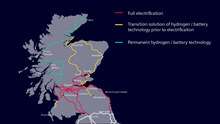Scotland is leading the way on transport decarbonisation but can go further and faster to speed up electrification plans, introduce hydrogen / battery trains and reduce reliance on ‘dirty diesels’, according to Siemens Mobility.
William Wilson, CEO of Siemens Mobility Limited, said: “There’s no doubt that the Scottish Government, Transport Scotland and Scotland’s Railway are focused on decarbonisation. They’ve already committed targets ahead of those in England.
“The real question is, are those targets achievable under current plans? The answer is yes, if Government and industry work collaboratively, but speed is essential.”
Current plans to decarbonise Scotland’s railway network, with a 2035 target enshrined in law, are challenging. Some 1,800 single track kilometres (STK) of electrified railway have been identified* as required to hit targets.
Siemens Mobility’s analysis highlights that, to support Scotland’s targets, urgent decisions need to be taken on which routes to prioritise for electrification. Viewing the railway as a whole system, including trains, track and signalling, and considering the latest innovations to make electrifying routes quicker and more efficient is also essential.
Additionally, Siemens Mobility has identified a number of key rail routes which would benefit from hydrogen or battery trains, helping address connectivity and transport poverty issues in rural areas.
Scotland already leads the way in hydrogen infrastructure investment, such as in Glasgow and Aberdeen, but these pilot projects now need to be scaled up to ensure a hydrogen supply chain for the railway.
From information released by Transport Scotland, Siemens Mobility has identified a number of major routes, currently operating diesel trains, for replacement and upgrade by 2035. This includes a combination of full and discontinuously electrified routes (where trains run on electric power where it is available, and switch to an alternative source as necessary) and the introduction of hydrogen and hydrogen / battery bi-mode trains to help replace current diesel and diesel bi-mode fleets.
The Scottish government’s current decarbonisation plans already include greener new trains for the West Highland lines, the Far North and Kyle of Lochalsh lines and the Stranraer line. A further four railway lines have been highlighted where partial electrification, using green bi-mode trains, could be used as an interim solution to full electrification and help Scotland meet their targets more quickly. These are: the Fife Circle, the Borders Railway, the Highland Mainline and the Aberdeen Mainline.
William Wilson, CEO of Siemens Mobility Limited added: “It’s clear that to meet the 2035 targets, Scotland needs to remove dirty diesel trains from the rail network, continue to introduce green alternatives and work at speed. And that doesn’t mean relying on diesel bi-mode technology.”
He continued: “There’s been much said about the short-range and low-speed of hydrogen trains. That’s simply incorrect. Our solutions are capable of travelling at 100mph, have similar acceleration to an electric train and have up to a 600-mile hydrogen-only range. In addition, electric, hydrogen and battery trains are faster, cleaner and greener than the diesels they will replace.
“There’s also a lot of chatter about the need to offer either hydrogen OR electric technologies. Again, that’s misleading. They can be used in tandem to offer a well-rounded solution to Scotland’s transport challenges of today. What is absolutely clear is the need to act quickly. Scotland’s climate challenges are real and current and meeting decarbonisation targets will only happen if action is taken now.”
Last year Siemens Mobility and Siemens Energy signed a Memorandum of Understanding to develop and offer hydrogen systems for trains and enable complete solution delivery – from trains, to refuelling, to the supply chain– to drive the sector and pave the way for sustainable and climate-friendly mobility. Siemens Energy with Siemens Gamesa have invested into development of an industrial scale system of harvesting green hydrogen from offshore wind.
*Source: Scottish National Transport Strategy
Ends



